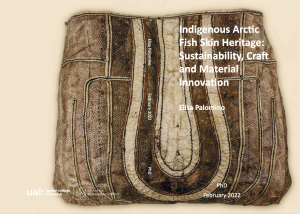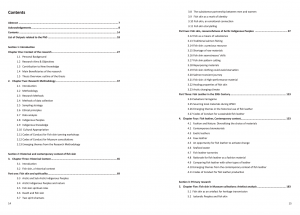Palomino, E. (2022) Indigenous Arctic Fish Skin Heritage: Sustainability, Craft and Material Innovation. PhD Thesis. University of the Arts, London.
The use of fish skinfor the construction of garments and accessories is an ancient tradition shared by coastal Arctic societies as a subsistence lifestyle depending on aquatic resources for food and clothing. Arctic Indigenous Peoples need formidable resourcefulness to thrive in inhospitable ecosystems; fish skins provide them physical and spiritual protection(5). During the last century, they resisted not only colonisation and repression by humans but also dramatic ecological changes in seafood security. Fish skin craft became a way to communicate traditional knowledge where practical benefits combined cultural resilience. As market goods have replaced traditional fish skin clothing, the need for the skills required to create these items have diminished. The decrease of local natural resources also threatens the craft.
The focus of this research is primarily to propose a vision of sustainability as an anthropological study of the resourcefulness and resilience of the Arctic Indigenous Peoples, their lifestyles, and fish skin practices. Secondarily it identifies the historical, cultural, environmental, and socioeconomic importance of fish skin as an innovative sustainable material, explored through the study of materials, processes and artefact analysis. Thirdly, the application of fish skin materials and craft practices has been tested through participatory workshops to explore how this material and the skill transmissions can contribute to sustainability practices in fashion.
The contribution to knowledge is firstly the mapping of fish skin craft participatory practices with Artic Indigenous communities as this is the first time that such a survey has been undertaken. The material study of fish skin and its contribution to fashion sustainability forms a secondary contribution.
https://ualresearchonline.arts.ac.uk/id/eprint/20124/
- Palomino, E., Pardue, J., Donkan, A. (2023) Fish skin Peoples of the Bering Strait: Encounters in Hokkaido, Japan. Smithsonian Institution National Museum of natural History. Arctic Studies Center Newsletter. May 2023. N.30. pp.74-75
- Palomino, E. (2022) Indigenous Arctic Fish Skin Heritage: Sustainability, Craft and Material Innovation. PhD Thesis. University of the Arts, London.
- Palomino, E., Cloud, J. (2022) The Arctic as viewed from Florence. Arctic Studies Center Newsletter, Smithsonian National Museum of Natural History.
- Palomino, E. (2021) Fish Skin Coat from the Amur River. TEXT for the Study of the History Art Design of Textiles. V. 48: 2021. The Textiles Society, Pat Frost (ed)
- Trachter, F., Palomino, E., Defeo, G. (2021) Patagonian fish skin tanning processes. XXXVI IULTCS Congress Greening the Leather Value Chain
- Palomino, E., Pardue, J. (2021) Alutiiq Fish Skin Traditions: Connecting Communities in the COVID-19 Era. MDPI Heritage, 4, x. Academic Editor(s): Claire Smith.
- Palomino, E., Pardue, J., (2021) A virtual Alutiiq Fish Skin workshop during Covid-19 times. Smithsonian Institution National Museum of natural History. Arctic Studies Center Newsletter. May 2021. N.30.pp-16-17
- Palomino, E., Freilich, O., Raine, I. (2021) 'A virtual Ainu fish skin workshop during Covid 19'. Global Fashion conference. Academy of Fine Arts of Warsaw. ISBN: 978-989-54263-2-4
- Palomino, E., Karadottir, K. (2021) Fish skin, a historical material assimilated as a sustainable material for fashion. In: Fashion: Culture, Craft, and Identity. Brill.
- Palomino, E., Boon, J. (2020) Preservation of Hezhen Fish Leather tradition through Fashion Education. Textiles, Identity and Innovation. Taylor & Francis.
- Palomino, E. (2020) Fashion workshop in Anchorage. Smithsonian Institution National Museum of natural History. Arctic Studies Center Newsletter. May 2020. N.27.pp. 57-58
- Palomino, E., Karadottir, K., Phirry, E. (2020) Indigenous Fish Skin Craft Revived Through Contemporary Fashion. International Foundation of Fashion Technology Institutes Journal. ISSN: 2694-5193
- Palomino, E. Defeo, G. (2019) Material Design Research - Fish skin, a new environmental -friendly material for fashion. Design Research for Change. Design Museum, London ISBN 978-1-86220-369-3
- Palomino, E. Rahme, L. Karadottir, K. (2019) Indigenous Arctic Fish skin clothing traditions: Cultural and ecological impacts on Fashion HE. CUMULUS Conference Rovaniemi. ISBN 978-952-337-158-3.
- Palomino, E. (2019) SDG 14 Life Below Water Introducing Fish Skin as a Sustainable Raw Material for Fashion. In: Franco I., Chatterji T., Derbyshire E., Tracey J. (eds) Actioning the Global Goals for Local Impact. Science for Sustainable Societies. S


